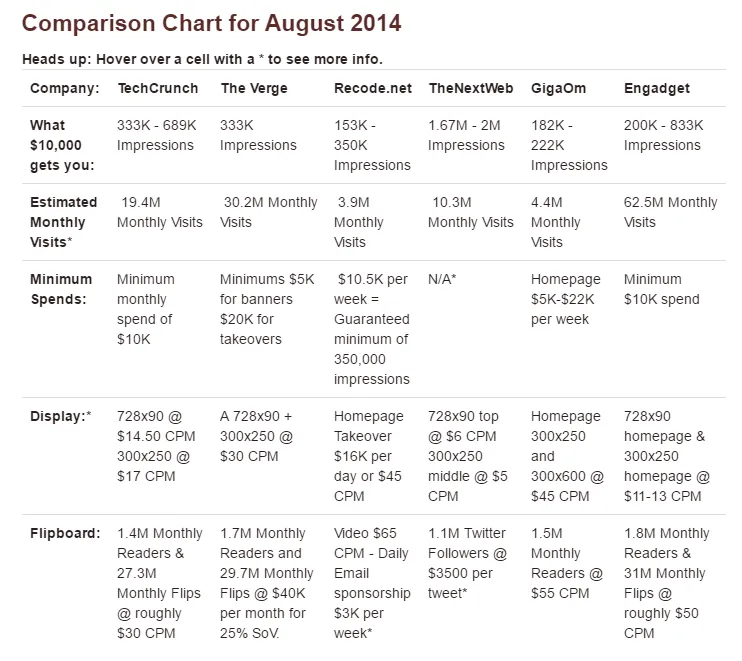What does $10,000 of ads get you?
You’re a media buying ace.
Out there buying display ads with a variety of services like Google/AdRoll and placing sponsored content with Facebook/Twitter…
The ROI is profitable but you’re looking to experiment with different channels. There’s a few startups out there that have new advertising techniques you can use (check out Hublo), but there’s still another opportunity that is mostly ignored…
And that’s media buying with tech publications like TechCrunch, The Verge, Recode and TheNextWeb. It looks like the next logical step, they definitely attract a quality and targeted audience.
So I decided it was worth my time to do some digging last week and sift through the publicly available media kits to roughly find out how much it would cost to run a campaign with them.
I thought I’d do the rest of you a favor and compare the options side-by-side so you can pick for yourself. This is by no means an exhaustive list of the advertising options these companies offer, but it’s a great jumping off point for tech media buyers that are looking to throw upwards of $10K into a campaign.

One of the more interesting themes we found while pulling together this data was the use of Flipboard as an advertising medium.
I was able to find some data from a Nielsen/Flipboard study that shows technology focused magazine display units get a CTR of 2.3%. As well as the magazines attracting an 8.1% subscription rate and an average of 9.1 flips per reader. They are showing great engagement and overall ad performance on their content which will lead them to demand a strong share of the mobile ad buying industry.
Bonus: Media Buying Definitions
Above The Fold: This is the portion of a Web page that is visible in a browser window when the page first loads. It typically refers to the very top of the webpage and is widely regarded as the highest value ad inventory on the web.
Behavioral Targeting: This is the placement of advertising across a network of many websites and is only displayed to specific visitor demographics.
Click-through Rate: This is simply the amount of users who click on a display ad campaign. It is found by taking the number of clicks generated and dividing it by the number of impressions served.
Contextual Advertising: This is when display ads are shown to a visitor and they match the websites’ content or the keywords used by the visitor. For example a visitor looking at a web development blog might be served a display ad for a web development tool.
Interstitial Ads These are usually full-page advertisements that are shown to a visitor when they are moving in between web pages.
Retargeting: This is the type of advertising that works to re-engage potential consumers that have previously visited a websites’ checkout process. The visitor is shown display ads across multiple web sites for a specific time period or specific frequency.
We hope you can use this information to help guide your next media buying campaign!